2023 Kia Sportage First Drive Review | Bigger, greener, off-roadier
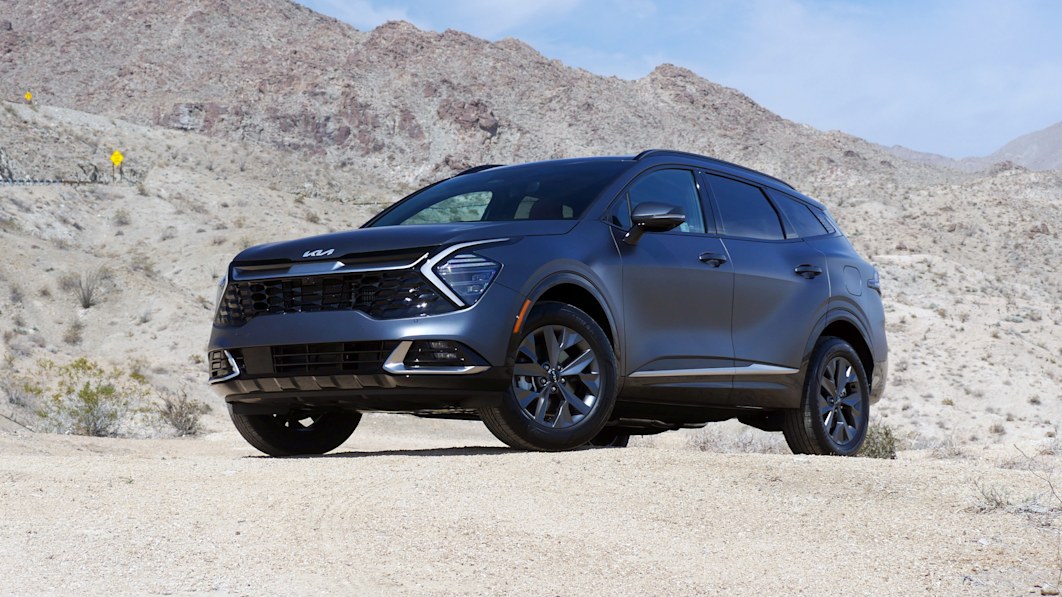
The Kia Sportage has always been one of the smallest compact SUVs, and for the last two generations, has been a value-packed, style-conscious alternative to the bigger, more family-friendly CR-Vs of the world. The trouble is, there’s now a boatload of similarly small alternatives we call midcompacts. Kia even makes one of them, the Seltos. That frees the 2023 Kia Sportage to move up in the world.
Literally. The Sportage is now just about the biggest in the compact segment. It’s 7.1 inches longer overall with an extra 3.4 inches of wheelbase. Cargo capacity, which was previously sacrificed to provide surprisingly generous rear legroom, is now a segment-best 39.6 cubic-feet. Backseat legroom expands even further to be a class leader itself with 41.3 inches. These aren’t just incremental generation-to-generation differences, they are complete game-changers. The Sportage goes from a choice best suited to single folks, DINKs or empty nesters to one that’s family-friendly.
It’s also a difference you can absolutely tell just by looking at the thing. Compared to its two immediate predecessors’ athletic, wheels-to-the-corners profiles, the new Sportage’s added length makes it a tad gawky and reminiscent of the even larger Sorento. This is countered by far more expressive styling. The expansive grille bordered by huge boomerang LED headlights is striking, and possibly off-putting, since it prevents the 2023 Sportage from having the “face” we expect cars to have. The rear is similarly bolder than the Sorento, with a concave liftgate and full-width taillights that evoke the EV6.
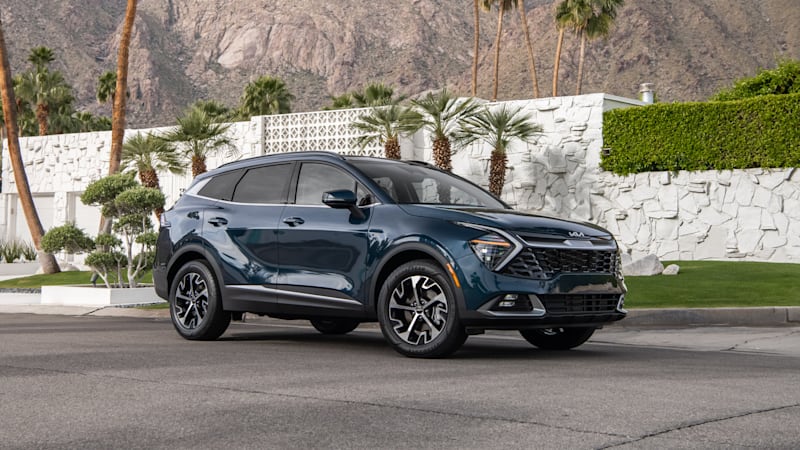
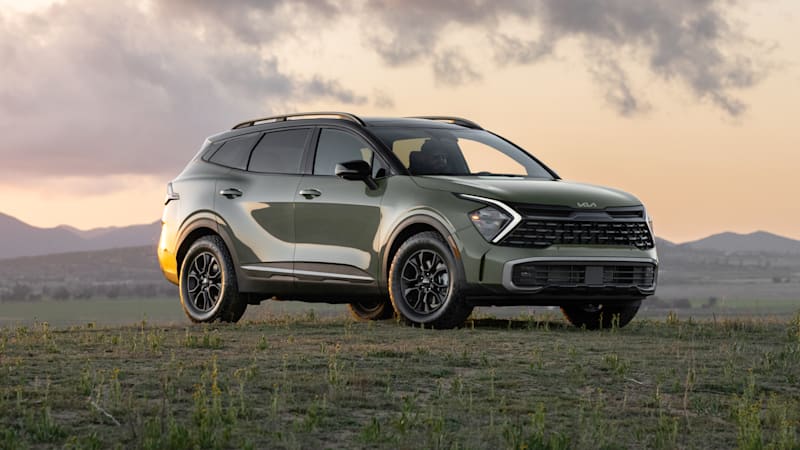
There’s not just one new look, though. Like Kia’s other SUVs, the Sportage gains a new X-Line trim level with different bumpers, gloss black trim, exclusive wheels, raised roof rails and a tread-like stitching pattern in the SynTex upholstery. Unlike the Sorento X-Line, though, ground clearance remains the same as every other all-wheel-drive Sportage at a reasonably lofty 8.3 inches (that’s 1.5 inches higher than the last Sportage, and 0.1 better than the Sorento X-Line). Should that sound too much like an appearance package to you, there’s also the new X-Pro (pictured above right), which goes a bit further by adding B.F. Goodrich all-terrain tires, 17-inch matte black wheels and recalibrated drive mode settings for reduced traction conditions. Oh, and a black roof.
While the tires no doubt improve the Sportage’s off-road capability, and a quick trek around a prepared off-road course showed the lockable all-wheel-drive system capable of dealing with various wheel-off-the-ground scenarios, this is at most a minor step beyond a Mazda CX-50 rather than a match for the Subaru Forester Wilderness or Jeep Cherokee Trailhawk. You also have to deal with a firmer and jigglier ride, more road noise and a degradation of road holding due to those admittedly cool tires. The steering at least remains commendably precise, which is good, since it’s generally a strong suit of the new Sportage along with commendable body control.
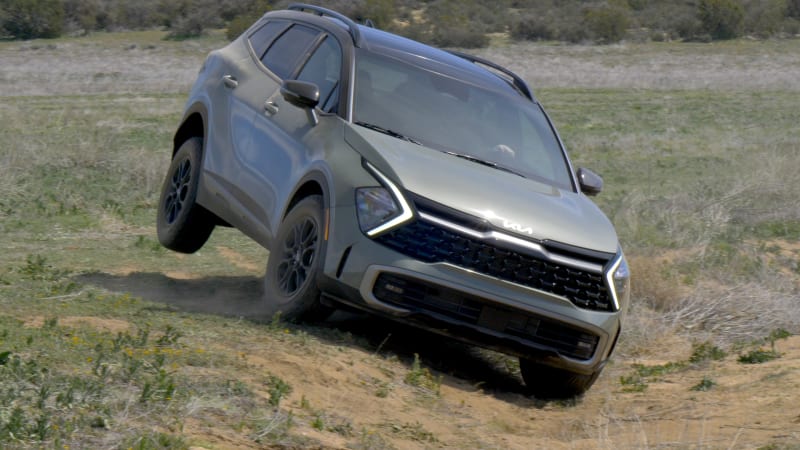
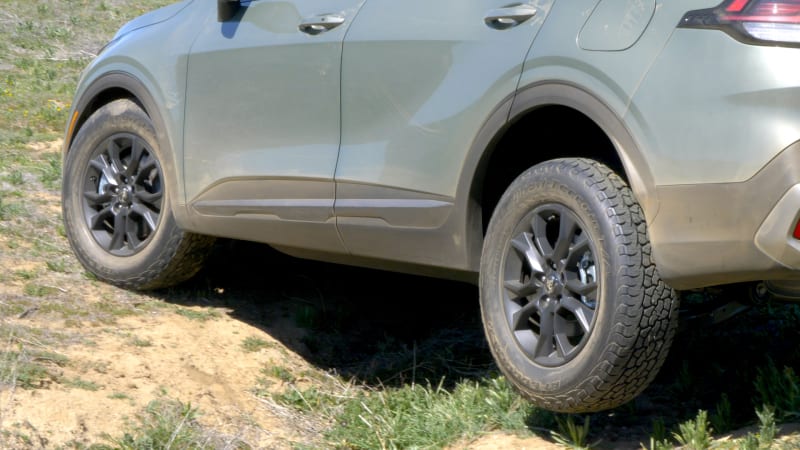
Perhaps a greater folly is that you’re stuck with the base engine, which, to be fair, is the same situation as the Forester Wilderness and Toyota RAV4 TRD Off-Road. The Sportage comes standard with a new 2.5-liter inline-four that produces 187 horsepower and 178 pound-feet of torque – pretty average for the segment. It’s attached to an eight-speed automatic, which is a good thing considering so many competitors have a CVT. Together, they offer sufficient acceleration and response (especially in the well-tuned Sport mode), and a slightly gravelly soundtrack. Basically, if you told us this was the RAV4 engine, we wouldn’t be surprised.
There is an exceptional alternative, however. While other compact SUVs offer you the option of either a hybrid or performance upgrade, the Sportage puts forth a two-for-one deal. The new Sportage Hybrid, much like the mechanically related Hyundai Tucson Hybrid, features a pairing of 1.6-liter turbocharged inline-four, electric motor, six-speed automatic and either front- or all-wheel drive. The latter is the same mechanical system found in the gas-only Sportage, unlike the RAV4 Hybrid that achieves all-wheel drive by powering the rear wheels with an added electric motor. Total output is 227 horsepower and 258 pound-feet of torque, which falls well short of a Mazda CX-5 and CX-50’s turbo-only engine upgrade, but still represents a solid jolt of thrust.
The result is a win-win-win. The turbo hybrid is more pleasant to drive than both the base engine and other hybrids, thanks to its conventional automatic (versus some form of CVT) and the turbocharger that seems to smooth out the transition between electric and gas power sources in terms of both sound and power distribution. The turbo-plus-electric-motor combo also makes it feel notably gutsy around town and when passing and, despite the small-displacement engine, is quieter when you punch the throttle. Finally, as expected, it’s much more efficient, at either 43 or 38 mpg combined depending on drivetrain and trim level, versus 28 mpg combined (FWD) and 25 mpg (AWD) for the gas versions.
Better still, the hybrid only costs about $1,000 more than a comparable engine-only model (prices differ by a few hundred based on trim). You’ll have that premium paid off in no time thanks to gas savings, then continue to enjoy the performance advantage with house money.
It’s not the only hybrid, though. The 2023 Kia Sportage PHEV arriving later this year features the same powertrain bolstered by a substantially larger, plug-in-able battery. Full specs and pricing are to come, but the Tucson PHEV should be a good indicator of what to expect. We do know it’ll offer an estimated 32 miles of electric range, which falls short of the Toyota RAV4 Prime, but should still be a perfectly useful range capable of covering most round-trip commutes.
Here’s the wrinkle, though. American customers are digging the outdoorsy look and extra capability of models like the X-Line. The Sorento, for instance, received more X-Line trim level pairings for 2022. And while the Sportage PHEV will be available as the X-Line, the hybrid will not, and neither can be had as the X-Pro. This may be consistent with the Toyota RAV4, which doesn’t offer its more rugged Adventure and TRD Off-Road trims as hybrids (let alone Subaru or Jeep who don’t offer hybrids at all), but unlike Toyota, Kia can actually pair its mechanical all-wheel-drive system with its hybrid powertrain. According to Sportage product planner Derrick Ty, the lack of a hybrid/X-Line combo is currently as much about supply constraints as it is about anticipated demand. Basically, Kia can’t make enough hybrids at this time. It’s the same reason Kia expects only 20% of 2023 Sportages to be hybrids. In time, and with eased supply burdens, that percentage could go higher (much as it is for the RAV4 Hybrid), and Ty said his team will be monitoring whether customers actually do desire the hybrid/X-Line combo.
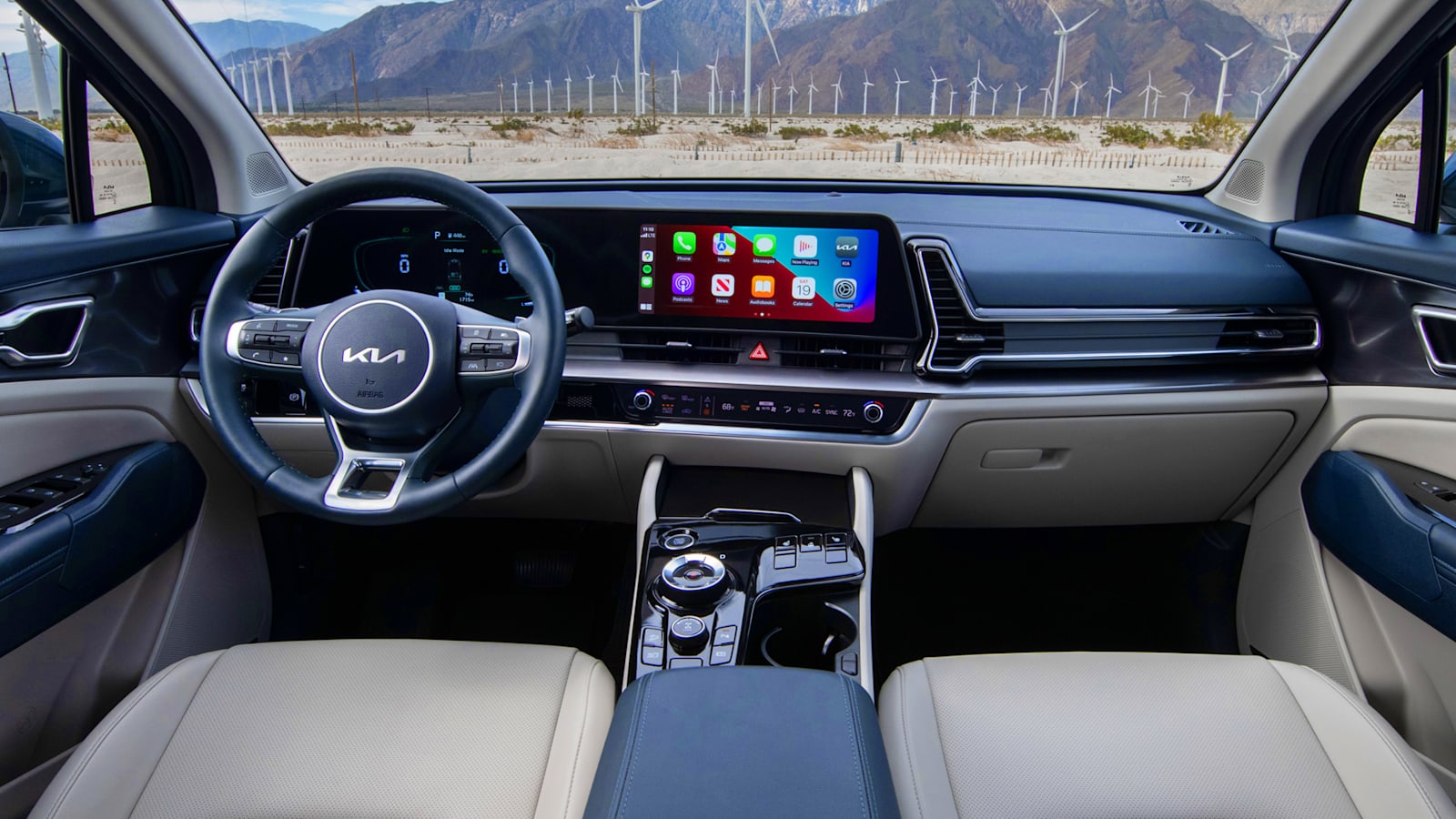
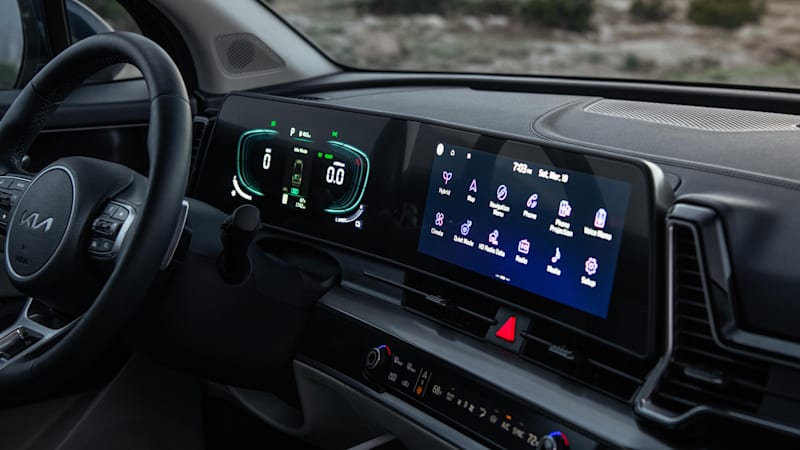
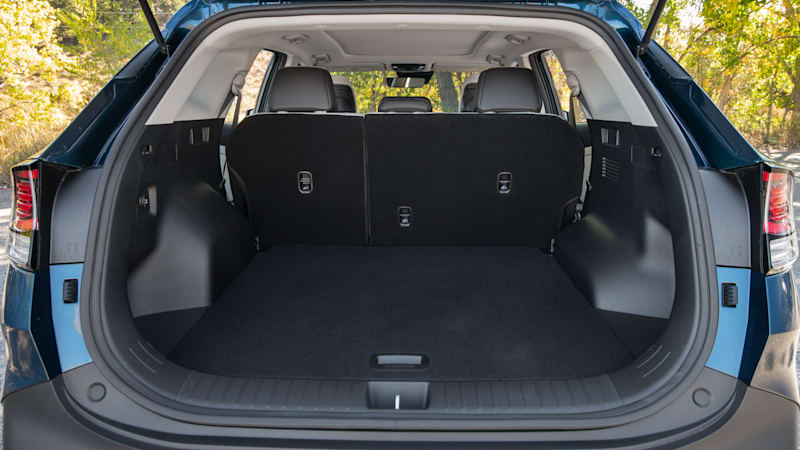
The new Sportage’s interior represents another advantage over the segment’s best sellers. In short, it’s cool. There’s a sense of style here you ain’t getting with a CR-V or Forester. Beyond the design, there are red, navy and sage green interiors available depending on trim level and drivetrain, with even the EX Hybrid eligible for a particularly cool Misty Gray and Triton Navy combo. Ty says he made sure to include such aesthetic options along with Kia’s usual generous feature content on lower trim levels because he hated the idea of short-changing folks who can’t pay top dollar for top trim levels. It’s an ethos he picked up while working for Disney for several years – basically, every guest deserves a magical experience regardless of their budget.
Another example of this is the cabin’s main attraction: the giant curved panel housing twin 12.3-inch displays shared with the EV6. Found on every trim but the LX, it’s not only an eye-catcher for its curved design and pretty graphics, but like other Kias, the infotainment touchscreen is easy to use. Joining it from the EV6 is the unique row of touch-capacitive “buttons” that serve double duty as climate controls and infotainment menu shortcuts. I can see how it could be annoying, but I was also OK with them in my week with the EV6.
Well-executed driver assistance tech is in abundance, with forward-collision warning, lane-keeping assistance and driver inattention warning all standard. Blind-spot warning is included with the EX and above, while Kia/Hyundai’s excellent adaptive cruise control system with lane-centering steering assistance shows up on the SX trims. ACC comes standard on every CR-V, RAV4 and Forester, but Kia’s system generally works better.
Add it all up and the 2023 Kia Sportage looks like an absolute winner for the segment. It now has the space needed for family duty and the electrified versions demanded today for multiple reasons, while maintaining the combo of distinctive style and strong value that’s been a Sportage staple for two generations. Pricing starts at $27,245, including destination for a base FWD LX. That’s right in between the CR-V and RAV4, so don’t expect bargain basement for a Kia in 2023. And you really shouldn’t, considering how good and competitive this car is. That said, the LX Hybrid price of $28,545 is a few grand lower than the CR-V and RAV4’s hybrid entry points. Even that EX Hybrid with the snazzy navy blue interior is around $1,000 less than the base CR-V Hybrid EX. That’s just one more reason to consider the Sportage Hybrid the pick of the litter – you’ll just have to live without the X-Line’s quasi-rugged flourishes. At least for now.
Related Video:



